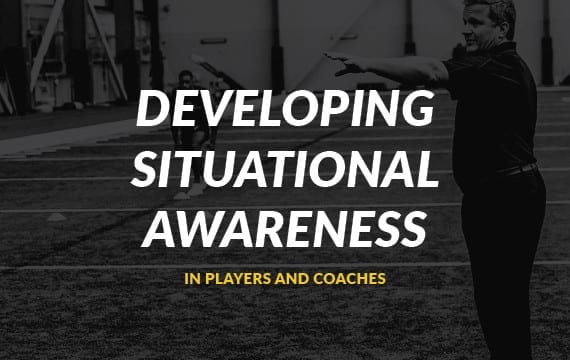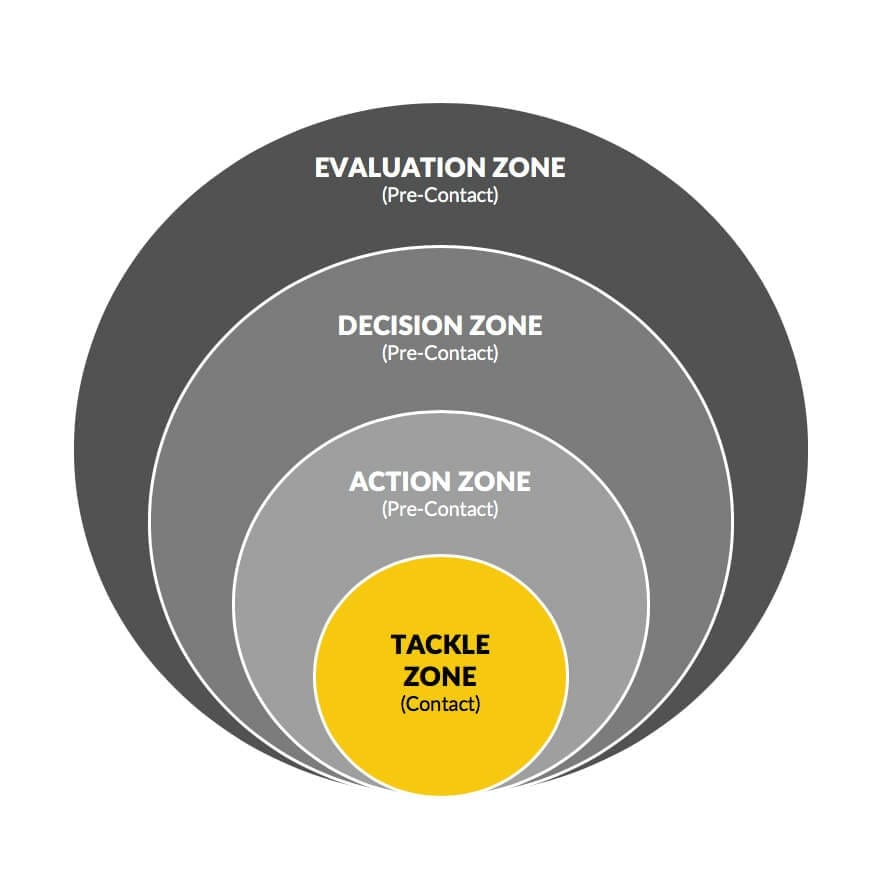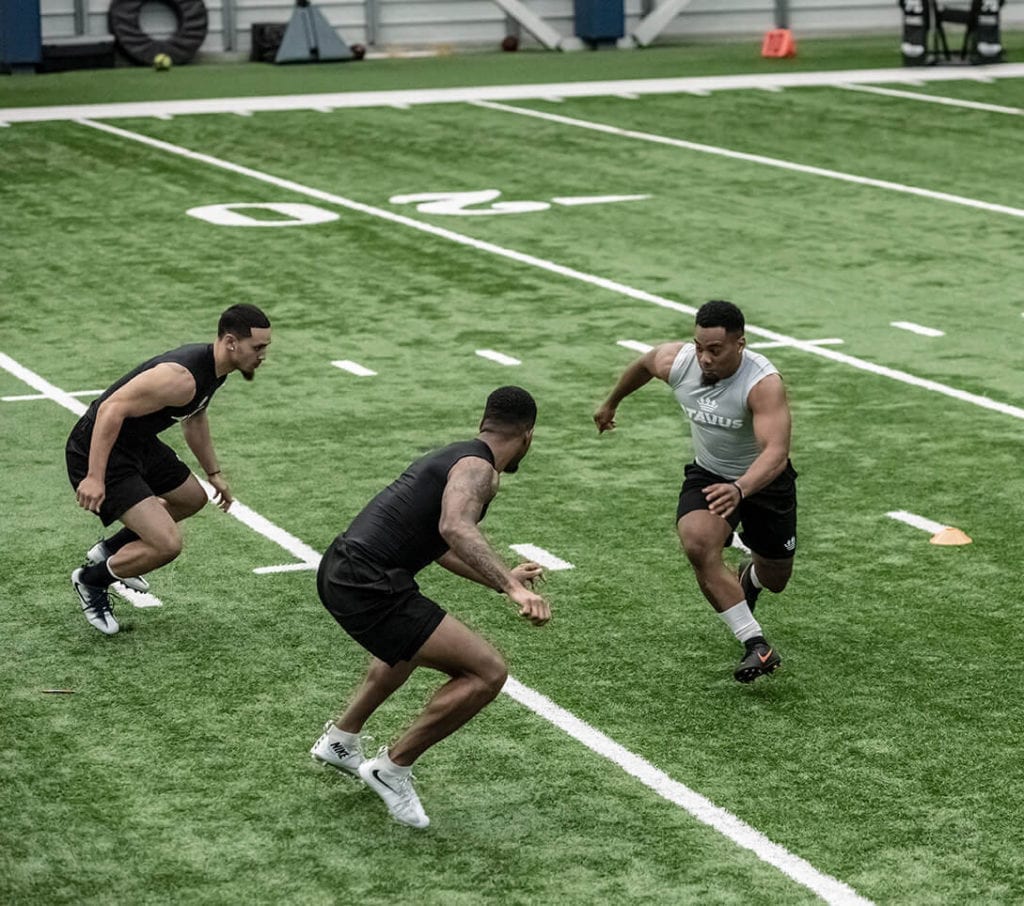| The ability to interpret a situation and execute relevant techniques is fundamental to playing a more effective and safer game. |

Taylor Kempf, May. 21st 2019
Every parent understands the danger of a young child at a busy intersection. We take their hands and become very aware of their movement, knowing that their lack of experience could put them in harm’s way. The child understands the “how” of crossing the street but lacks the situational awareness to understand that speeding cars present a risk.
The same understanding that keeps us safe at a busy street crossing can keep us safe on the playing field. As coaches, one of the most important areas to develop in our players is situational awareness.
Situational awareness is the ability to interpret a situation and execute the techniques to be effective and safe. Some coaches view this as “football instincts” and believe a player either has or does not have it. At Atavus, we know that situational awareness can be taught and improved. Kids without it can develop awareness at the same time they improve technique. Players with good situational awareness can be coached to be even better.
Let me give you an example. In the opening game of the season a few years ago, I put one of my best athletes on the kickoff team. Although he would grow to become a tremendous player, at the time he was just learning the game. New players play in a tunnel. It was his first game and he didn’t anticipate blocker coming from the side. Not seeing it coming caused him to miss a few games. It was my fault; I should have known he wasn’t ready because he lacked the situational awareness needed for what he was being asked to do.
In fact, understanding the situational awareness of your players is one of the best things you can do as a coach.
Dr. Art Maerlender, Director of Clinical Research at Center for Brain, Biology, and Behavior at the University of Nebraska, has studied concussions in youth sports for most of his professional life. His work has improved our understanding of player injuries. He sees injuries in two forms. First, the most common cause of injury to the head is rotational force. Second, most injuries to the body are caused by the neck not being in a neutral position. Players who cannot anticipate contact or position their body into safer positions stand a higher risk of injury.
In other words, the roots of many injuries can be found in poor body position prior to contact, not just the force of the contact itself.

Thus, one of the chief benefits of situational awareness is that it allows the player to initiate or react to contact in the most effective and safest way possible in that moment. to initiate contact in the best way possible at that moment. A more aware player is a safer player.
Atavus addresses this with technique. We divide the tackle into precontact and contact. In both areas we emphasize zones of execution: evaluation, decision, action, and contact. Through every zone the coach needs to create new levels of awareness so that kids tackle safely and effectively, but the evaluation and decision zones are the most important initially.
We want to see the player properly identify the ball carrier and close space effectively. Once he decides he is a tackler, we want him to take angles with the intent to use the near shoulder to make contact. Our drills philosophy is to reinforce technique while helping the players understand when and how contact is going to happen.
As if improved safety is not enough of a reason to focus on situational awareness, coaches also find that performance increases as players learn more and improve their execution.

I see that coaches who invest time on situational awareness in the spring and pre-season accelerate player development before the first game of the season. Imagine going into your first game with a team tackling in mid-season form; the benefits are enormous.
This can be achieved, not surprisingly, through the use of drills that develop awareness. Extending tackling drills to include decision making elements advances the player beyond technique and to a higher level of understanding. Additionally, challenging players in practice so that they make bad decisions is part of the learning process. You need to know that they can execute technique with proper decisions in game situations as pressure increases. The best way to do this is to make practice relevant by making the drills resemble what they will experience in the game. Teaching tackling is easy, developing great tacklers takes a focused approach, hard work and a goal to make practice harder than what they will experience in the games.
Finally, helping all your players with situational awareness allows you to rely less on your top performers. Most kids do not have dominant force when they hit. Taking your team to a higher level requires that all players understand how to tackle.
With both safety and performance benefits, most coaches would agree that situational awareness is a key part of the game. However, most coaches assume they are already looking at it yet in my experience few truly spend time developing it in themselves. Can you see an injury before it happens? Is your situational awareness better than your players? If your situational awareness is poor, your players will be poor or worse.
The first step in coaching better situational awareness is use of a common language among coaches and players to describe what they see. Creating a standard accelerates player growth because the coaching is consistent. Eventually you will see that players begin to coach each other with this language as it becomes second nature to them.
A great example of this is the experience of Rockwall High School in Texas where, in 2015, each position group coach taught tackling differently, typically based on how he learned as a player. When head coach Rodney Webb committed to a single approach, player and coach confidence grew. Best of all, from 2016 to 2018, Rockwall saw a 33.8% decrease in missed tackles and zero tackle-related concussions.
Coaching situational awareness helps you with your own situational awareness. Practice with intent and keep challenging your players. Theoretically, if your players are getting better the drills should continue to be more difficult, or your players’ skill level will plateau.
Is complete situational awareness possible for every player? No, but that’s not the goal. Your goal is to make your team better. I believe that improving situational awareness creates a better foundation for your team, and time invested in increasing player understanding will pay dividends season after season.